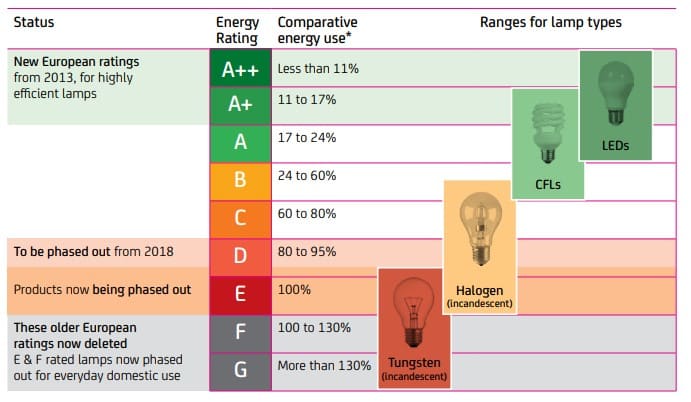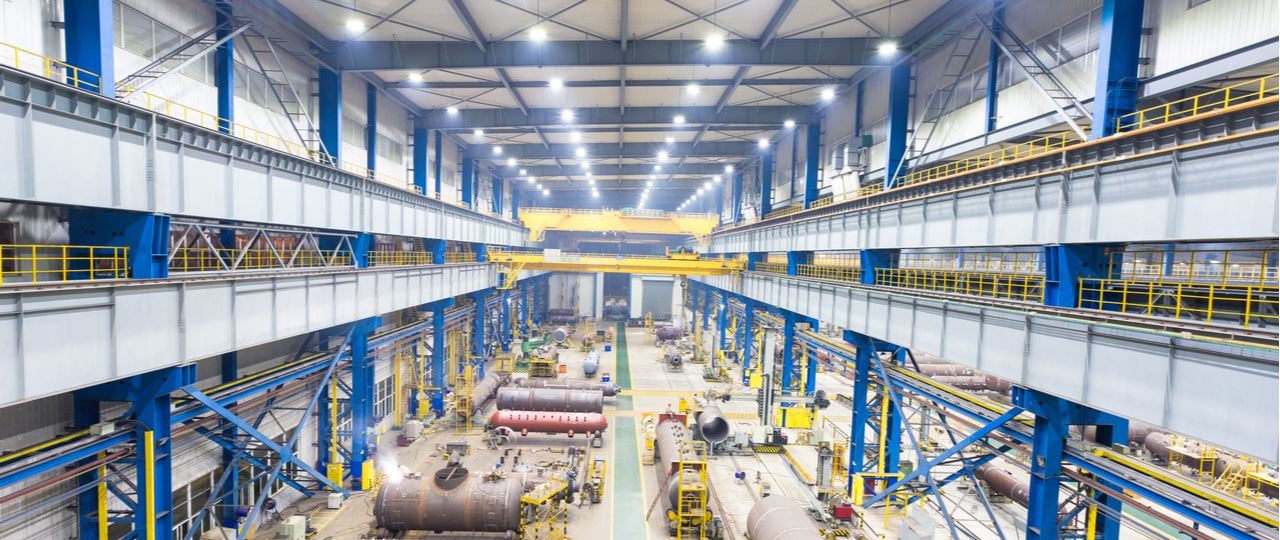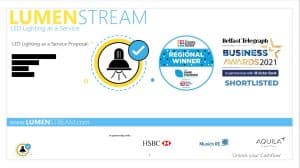Learn more about how LED lighting upgrades work and discover how to achieve energy efficiency with LEDs in your business.
If you’re thinking about upgrading your lights to LED, now is the time to do it. With everyone experiencing rising energy costs, we need solutions to lower our energy consumption.
LEDs can help lower your energy bills by as much as 70%, or even 90% when incorporating motion sensors. That can amount to a lot of money when you have big spaces to light up, such as in food processing plants, logistics warehouses, or manufacturing facilities.
Think: if your business’ energy bills are coming to £100,000 a year, you could reduce that by £80,000, leaving you with a bill of £20,000. Just by changing your lights.
In short, an LED upgrade offers an incredible opportunity to free up your budget for something else. But, to make sure your LED upgrade is successful, you’ll need to arm yourself with some basic knowledge.
Luckily, in this post, we’ll provide an all-you-need-to-know rundown of an LED lighting upgrade. We’ll lay out the benefits and tackle some myths. But, most importantly, detail the 3 different ways you can get an LED installation for your business.
Download My Example Proposal
What are LEDs (and Why Do They Matter)?
LEDs are Light-Emitting Diodes. The name itself connects to why they are so important to our mission for energy efficiency.
Let’s break that down.
‘Light-emitting’: the main source of energy given off is light.
This is unlike incandescent bulbs that give off 90% of their energy as heat.
So, if what you want is light then you don’t want the object that is giving you that light to be using energy to give off heat. That’s wasted energy. That’s wasted money.
Compared to the alternatives, LEDs outperform in efficacy (lumens/Watts), rated lifetime (based on operational hours of use), and colour rendering index (CRI).
Therefore, by a simple switch from an old light fitting to an LED, you are becoming more energy efficient. Consequently, you will save your business money.
Don’t forget, if your business upgraded to LEDs over ten years ago, you probably also need to have an LED upgrade.
Additionally, the upgrade will help your business succeed in hitting any sustainability targets. Something all businesses need to be acting on to help do our bit for the planet.
And, if you go for the Lighting as a Service model for the upgrade, you even free up money straight away to spend on your core business.
The Benefits of an LED Lighting Upgrade
The benefits of an LED lighting upgrade for your business are numerous. Here are just 5 of the top reasons why you will want to change those old lights as soon as possible.
With an LED lighting upgrade you will:
-
Save Energy & Save Money
As already mentioned LEDs can save you a substantial amount of energy which translates to a staggering amount of money. This is especially true now with the recent increases in energy costs.
Nobody needs an explanation of why this is good for their business.
-
Have a safer work environment
Due to their design, LEDs are less prone to being a fire hazard as they are less likely to overheat than their alternatives. When fitted by a qualified electrician and the lights pass British Standards, LEDs are safer.
Further, they deliver better light. This is especially true when an expert calculates the best lighting levels for your space.
-
Long Lifespan
LEDs last longer than any alternative in their compared setting and operational hours of use.
-
Less maintenance
LEDs are far more reliable than the old alternatives meaning less hassle in organising the repairs/replacements.
-
Old lights are becoming obsolete
You might as well get ahead of the curve because soon you won’t really have much choice. Halogen light bulbs have been banned since September 2021 (although businesses are still allowed to sell their existing stock). Further, from 1st April 2023 owners/operators will not be able to continue letting a property with an EPC below E. In the coming years, this will increase to a higher EPC.

The Disadvantages of LEDs (or should we say myths)
There may be some disadvantages of LEDs that you have come across over the years. A changed landscape, more innovation in the technology and further research have addressed these points.
Myth #1 An LED upgrade is too expensive
Yes, if you buy LEDs outright, even though they are significantly cheaper than they were before, it is still a big outlay for a depreciating asset. Your upgrade could cost you as much as £150,000. Even big cash rich companies with the budget don’t want to spend this kind of money on lights and have to wait for the Return on Investment. Investing their capital expenditure in to their “core business” is ultimately their priority and lighting gets pushed to the bottom of the pile (especially if your existing lights are ‘still working’)
What many people do is just replace their old lights one-by-one as and when they break. However this approach is a false economy when you consider the levels of energy wastage that will occur during a prolonged infrastructure upgrade. Furthermore, the light will be unevenly distributed, lowering lighting uniformity and subsequently negatively impacting working conditions.
There are other options though- leasing and Lighting as a Service. Both these options will take this myth down and put an LED upgrade back on the table as a completely affordable opportunity (see more about these ways to upgrade below).
Myth #2 LEDs are bad for wildlife
Luckily, this is not too much of a problem when your LED upgrade is inside.
It all comes down to the type of LED you are using. LEDs and CFLs emit more blue light (which naturally comes from the sun) than incandescent bulbs.
However, choosing an LED light fitting with a warmer colour temperature of between 5000 and 7000k, rather than cool-white or blue-white, minimises this blue light emission. So, if you are putting LEDs outside, you can get savvy with your knowledge of colour temperature and select light fittings that aren’t going to hinder our wildlife.
Myth #3 LEDs are a health hazard
As with a lot of technology, research is ongoing to determine any adverse effects of the use of LEDs. However, much of the doubt with LEDs tends to be in their use on our computer, tablet and phone screens. The blue light emitted from LEDs can affect our circadian rhythm. All modern screens are able to reduce the amount of blue light given off by switching to ‘night lights’.
In terms of bigger spaces that use LEDs, like warehouses, again it is all down to the type of lamp you are getting. An LED lighting expert will be able to calculate the optimum levels of lighting for your space, ensuring British Standards are upheld and reduce the possibility of negative effects. The Scientific Committee on Health, Environmental and Emerging Risks (SCHEER) determined that there was ‘no evidence of direct adverse health effects from LEDs’.
3 Ways to Upgrade Your Lights to LEDs
There are quite a few companies that offer LED lighting upgrades, it can be overwhelming when it comes to making decisions about which company to go with. The first decision to make would really be which way you want to acquire the LEDs.
1) The Old Way- buy them from wholesalers
The way things have always been done. Deploy your capital expenditure and purchase the LED lighting yourself then pay a contractor to install it.
- You own the assets and can do whatever you want with them
- Best option for organisations with limited trading history
- Good option for businesses that have their own engineers with the capacity to install and maintain the assets
- High upfront capital cost;
- (Always remember – your capex today is worth more than it is in the future due to rising inflation)
- Wholesale products are heavily marked up before they reach the end user = bad value
- Capital tied up during payback period
- On-balance sheet transactions restrict investment in other areas of your business
- Assets depreciate over time = investment in assets with zero future value
- Enhanced Capital Allowance no longer applies = no tax breaks
- Time spent managing contractors = less time running your business
2) The Newer Way- lease them/Hire Purchase Agreement
Same story as the first option but you pay as you save over a specified time period on a credit basis by paying monthly installments. This is effectively a loan or credit agreement that will limit your financial options.
- You own the assets and can do whatever you want with them
- Zero upfront cost
- Project pays for itself
- Wholesale products are heavily marked up before they reach the end user = bad value
- Capital tied up during payback period
- On-balance sheet transactions restrict investment in other areas of your business
- Assets depreciate over time = investment in assets with zero future value
- Enhanced Capital Allowance no longer applies = no tax breaks
- Time spent managing contractors = less time running your business
- Interest/credit paid on top of assets
3) The Newest way- Lighting as a Service
Lighting as a Service allows you to pay as you save via a Service Contract that is specifically designed to be an Off-Balance sheet transaction that leaves no financial footprint.
- Zero upfront cost
- Zero risk
- Zero time investment, as project is managed, installed and maintained by the service provider
- Project pays for itself
- Immediate increase in net cashflow following upgrade
- No payback period
- Off-balance sheet transaction in line with IFRS 16 regulations = Zero impact on future cashflow or borrowing capacity
- Not suitable for small businesses
- Not suitable for companies with short leases on premises
- Not suitable for companies who seek mood lighting (eg, hotels or specialist retail stores)
Once you have made the decision of which way would be best for your company’s situation, you can then find the company that best fits that requirement.
Watch what one of Lumenstream’s clients, Siemens- Electrium Sales Ltd, thought about the Lighting as a Service model.
Tips and Reminders when Deciding on an LED Upgrade Model
Tip #1 Hire experts
You will want to make sure that you have experts carrying out your lighting upgrade.
First, have a qualified lighting design engineer design your new lighting system. Utilising incredible software tools like DIALux, a qualified lighting designer will be able to:
- calculate the exact levels of lux you will achieve at a working height,
- ensure high levels of lighting uniformity,
- configure minimal glare which could negatively affect your workforce.
Second, of course, you want a trusted qualified electrician to make sure the job is done properly and follows safety standards.
Tip #2 Consider what will happen with your old lighting fixtures
Potentially you could be looking at replacing 1,000 lights- who is going to take care of that waste? Under the WEEE system, UK businesses have an obligation to recycle their electrical waste in accordance with WEEE regulations. Lumenstream has partnered with Recolight to ensure your WEEE compliance so you don’t have to worry about that. Just saying.
Tip #3 Check what the deal is with maintenance
Who is going to be responsible going forward? What does your warranty mean? Your lighting manufacturer or supplier will provide you with a warranty stating the length of their product warranty. Warning! Always check the terms and conditions because these guarantees are limited by the number of hours of operational use throughout the year. So if you are a 24/7 operation, this is something that you need to carefully consider. Do the warranty terms only cover 18/7 hours of continual usage? Traditional lighting companies’ manufacturers do not include the cost of removing, testing and the engineer call out charge to replace a faulty light fitting. So make sure that you understand what levels of maintenance you will require going forward.
Thankfully, LEDs are very reliable but it is good to have cover if a light happens to break.
Conclusion
By now, it should be clear that an LED Lighting upgrade is a no-brainer. It will save your business energy, helping you reach those sustainability targets, and it will save your business money.
Out of the three main options of an upgrade, you stand to benefit the most from Lighting as a Service if you have long operational hours of use and large spaces to be improved with LEDs.
Download My Example Proposal


